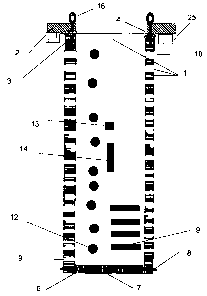Une partie des informations de ce site Web a été fournie par des sources externes. Le gouvernement du Canada n'assume aucune responsabilité concernant la précision, l'actualité ou la fiabilité des informations fournies par les sources externes. Les utilisateurs qui désirent employer cette information devraient consulter directement la source des informations. Le contenu fourni par les sources externes n'est pas assujetti aux exigences sur les langues officielles, la protection des renseignements personnels et l'accessibilité.
L'apparition de différences dans le texte et l'image des Revendications et de l'Abrégé dépend du moment auquel le document est publié. Les textes des Revendications et de l'Abrégé sont affichés :
| (12) Demande de brevet: | (11) CA 2530729 |
|---|---|
| (54) Titre français: | GRILLE A DEBRIS EN TAMBOUR |
| (54) Titre anglais: | BARREL DEBRIS TRAP |
| Statut: | Réputée abandonnée et au-delà du délai pour le rétablissement - en attente de la réponse à l’avis de communication rejetée |
| (51) Classification internationale des brevets (CIB): |
|
|---|---|
| (72) Inventeurs : |
|
| (73) Titulaires : |
|
| (71) Demandeurs : |
|
| (74) Agent: | |
| (74) Co-agent: | |
| (45) Délivré: | |
| (22) Date de dépôt: | 2005-12-28 |
| (41) Mise à la disponibilité du public: | 2007-06-28 |
| Licence disponible: | S.O. |
| Cédé au domaine public: | S.O. |
| (25) Langue des documents déposés: | Anglais |
| Traité de coopération en matière de brevets (PCT): | Non |
|---|
| (30) Données de priorité de la demande: | S.O. |
|---|
A system of deep well barrel debris traps for storm water polishing before
discharge to
groundwater recharge wells is disclosed herein. The debris trap is formed by
one or more
traps, which can fill up relatively in sequence. The debris trap captures
coarse sediment
and leaves which enter into the well portion of wells and aquifer recharge
wells. The
traps are designed to capture debris and sediment such as leaves, gravel, and
other large
debris which would plug filters or aquifer formations. By building the traps
in series
these can capture the entire stream flow, each can fill up individually and
when full, can
continue to allow substantial flows of water past the individual trap. When
used in
conjunction with Storm Water Infiltration wells and aquifer recharge wells the
debris
trap can extent the time between maintenance cycles, increase the time to full
cake
formation plugging of filters or the aquifer formation.
Note : Les revendications sont présentées dans la langue officielle dans laquelle elles ont été soumises.
Note : Les descriptions sont présentées dans la langue officielle dans laquelle elles ont été soumises.

2024-08-01 : Dans le cadre de la transition vers les Brevets de nouvelle génération (BNG), la base de données sur les brevets canadiens (BDBC) contient désormais un Historique d'événement plus détaillé, qui reproduit le Journal des événements de notre nouvelle solution interne.
Veuillez noter que les événements débutant par « Inactive : » se réfèrent à des événements qui ne sont plus utilisés dans notre nouvelle solution interne.
Pour une meilleure compréhension de l'état de la demande ou brevet qui figure sur cette page, la rubrique Mise en garde , et les descriptions de Brevet , Historique d'événement , Taxes périodiques et Historique des paiements devraient être consultées.
| Description | Date |
|---|---|
| Demande non rétablie avant l'échéance | 2010-12-29 |
| Le délai pour l'annulation est expiré | 2010-12-29 |
| Inactive : Demande ad hoc documentée | 2010-09-30 |
| Réputée abandonnée - omission de répondre à un avis sur les taxes pour le maintien en état | 2009-12-29 |
| Demande publiée (accessible au public) | 2007-06-28 |
| Inactive : Page couverture publiée | 2007-06-27 |
| Inactive : CIB attribuée | 2006-03-14 |
| Inactive : CIB attribuée | 2006-03-14 |
| Inactive : CIB en 1re position | 2006-03-14 |
| Inactive : CIB attribuée | 2006-03-12 |
| Exigences de dépôt - jugé conforme | 2006-01-31 |
| Inactive : Lettre officielle | 2006-01-31 |
| Inactive : Certificat de dépôt - Sans RE (Anglais) | 2006-01-31 |
| Demande reçue - nationale ordinaire | 2006-01-31 |
| Déclaration du statut de petite entité jugée conforme | 2005-12-28 |
| Date d'abandonnement | Raison | Date de rétablissement |
|---|---|---|
| 2009-12-29 |
Le dernier paiement a été reçu le 2008-12-29
Avis : Si le paiement en totalité n'a pas été reçu au plus tard à la date indiquée, une taxe supplémentaire peut être imposée, soit une des taxes suivantes :
Veuillez vous référer à la page web des taxes sur les brevets de l'OPIC pour voir tous les montants actuels des taxes.
| Type de taxes | Anniversaire | Échéance | Date payée |
|---|---|---|---|
| Taxe pour le dépôt - petite | 2005-12-28 | ||
| TM (demande, 2e anniv.) - petite | 02 | 2007-12-28 | 2007-12-19 |
| TM (demande, 3e anniv.) - petite | 03 | 2008-12-29 | 2008-12-29 |
Les titulaires actuels et antérieures au dossier sont affichés en ordre alphabétique.
| Titulaires actuels au dossier |
|---|
| JOHN VAN EGMOND |
| Titulaires antérieures au dossier |
|---|
| S.O. |